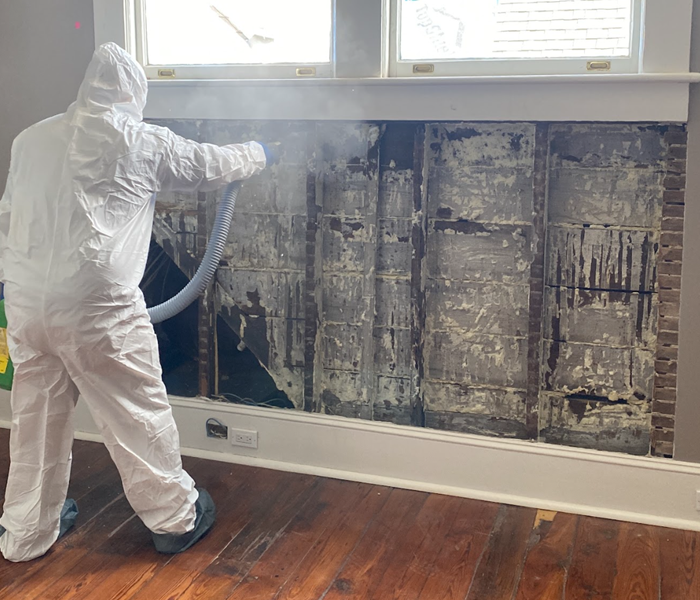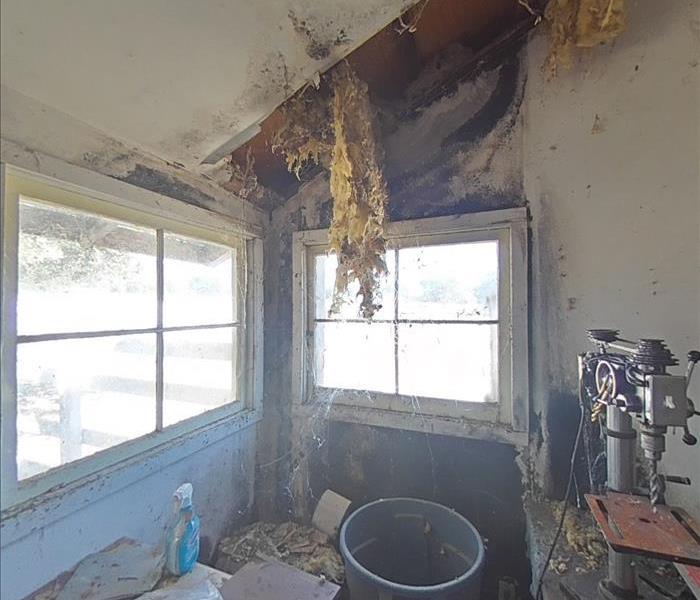SERVPRO of Santa Ynez/Goleta: Expert Mold Remediation Services
6/5/2024 (Permalink)
 SERVPRO® applying antimicrobial
SERVPRO® applying antimicrobial
At SERVPRO of Santa Ynez/Goleta, we pride ourselves on our extensive experience in mold remediation. Our team is meticulous and dedicated, ensuring clear communication with homeowners, property managers, and third-party testing companies to achieve successful remediation and restore normalcy.
Addressing the source of moisture intrusion is crucial, as mold can quickly reestablish itself if building materials become wet again. Mold is ubiquitous, but the goal is to prevent high indoor levels. Common culprits of indoor mold issues include leaky pipes, windows, roofs, skylights, exterior elevation problems (such as when landscaping accumulates and rises above the building), crawl space water intrusion, and insufficient crawl space ventilation.
Regular home maintenance is essential to prevent water damage, which can lead to mold growth and eventual structural damage. At SERVPRO of Santa Ynez/Goleta, we are committed to helping you maintain a safe and healthy living environment.
FAQs about Mold Damage
1/10/2023 (Permalink)
 Significant mold damage on a roof.
Significant mold damage on a roof.
What is Mold?
Mold, a type of fungus, is a diverse organism found in various environments, thriving in the presence of moisture and organic material. Its structure comprises hyphae forming a mycelium network, facilitating nutrient extraction and growth. Mold plays a crucial ecological role by decomposing organic matter and contributing to the recycling of nutrients. In indoor settings, it can become a concern when excessive moisture leads to its proliferation on surfaces. Mold reproduces through airborne spores, and understanding its biology is key to effective management and prevention strategies.
What does mold typically need to grow?
- Moisture: Mold requires water or moisture to grow. Areas with consistent or excessive moisture, whether from leaks, condensation, or high humidity levels, are favorable for mold development.
- Warmth: Mold tends to flourish in warmer temperatures, with the optimal range for growth typically between 77 to 86 degrees Fahrenheit (25 to 30 degrees Celsius).
- Organic Material: Mold feeds on organic materials such as wood, paper, fabric, and other cellulose-rich substances. These materials provide nutrients that support mold growth.
- Poor Ventilation: Inadequate airflow can contribute to stagnant conditions, allowing moisture to accumulate and fostering an environment conducive to mold.
- Low Light: While mold can grow in the dark, it is not dependent on light for growth. Dark and concealed areas can provide suitable conditions for mold proliferation.
Where does mold tend to grow?
Mold is a ubiquitous presence in nature, thriving in diverse settings due to its adaptability. In the outdoors, mold finds ideal conditions for growth in moist environments, such as soil, decaying organic matter, and the surfaces of plants and trees. It plays a crucial role in the natural decomposition of dead plant material, contributing to the nutrient cycle. Indoors, mold can be found in hidden or poorly ventilated spaces, taking advantage of moisture from leaks, high humidity levels, or condensation.
Common places for mold to grow in your home include:
- Bathrooms: Due to frequent water exposure and high humidity levels.
- Kitchens: Particularly around sinks and areas prone to spills.
- Basements: Where dampness and poor ventilation are common.
- Crawl Spaces: Often dark, damp, and lacking proper airflow.
- Attics: Where leaks or inadequate ventilation can lead to moisture accumulation.
- Around Windows: Condensation on windows can create a suitable environment.
- Behind Walls: Leaks or water damage can create hidden pockets of moisture.
- Under Carpets: Especially if carpets are exposed to moisture.
- Around Pipes: Leaks or condensation around pipes can promote mold growth.
- In Areas Affected by Flooding: Flooded areas may remain damp, fostering mold.
Understanding these common locations helps in identifying and addressing potential mold issues before they become more significant.
What should I do if I find mold in my home?
When you find mold in your home call SERVPRO®. Their trained technicians use advanced equipment and techniques to efficiently contain and remove mold, ensuring a thorough cleanup. With a focus on safety and efficiency, they handle potentially harmful substances for you as well as provide preventive measures against future mold growth. In most cases you shouldn’t attempt to remove mold on your own. Mold cannot just be cleaned, it must be removed.
What if I suspect there is mold in my home, but I don’t see it?
Call a qualified testing company, they will come in and test the rooms of concern and in many cases can tell you what species of mold are in your home. If the mold test comes back indicating that you have high levels of mold in your home, call SERVPRO so you can get that mold removed with peace of mind.
Preventing Future Mold Problems:
To prevent mold recurrence, address the source of moisture:
- Remove porous materials and replace them with non-porous ones like vinyl or linoleum.
- Repair leaks in the foundation, roof, or walls to prevent moisture entry.
- Ensure adequate ventilation for appliances using water to control humidity levels.
- Consider using a dehumidifier in mold-prone areas.
- Keep windows open during warm weather for fresh air circulation.
Understanding the nature of mold, its growth conditions, and common locations in both indoor and outdoor environments is essential for effective mold management. When encountering mold issues at home, it is advisable to seek professional assistance, such as contacting SERVPRO, to ensure safe and efficient mold removal. Additionally, if mold is suspected but not visible, consulting a qualified testing company can provide valuable insights. Taking preventive measures by addressing the source of moisture, using non-porous materials, and maintaining proper ventilation can contribute to a healthier living environment and minimize the risk of recurrent mold problems.





 24/7 Emergency Service
24/7 Emergency Service

